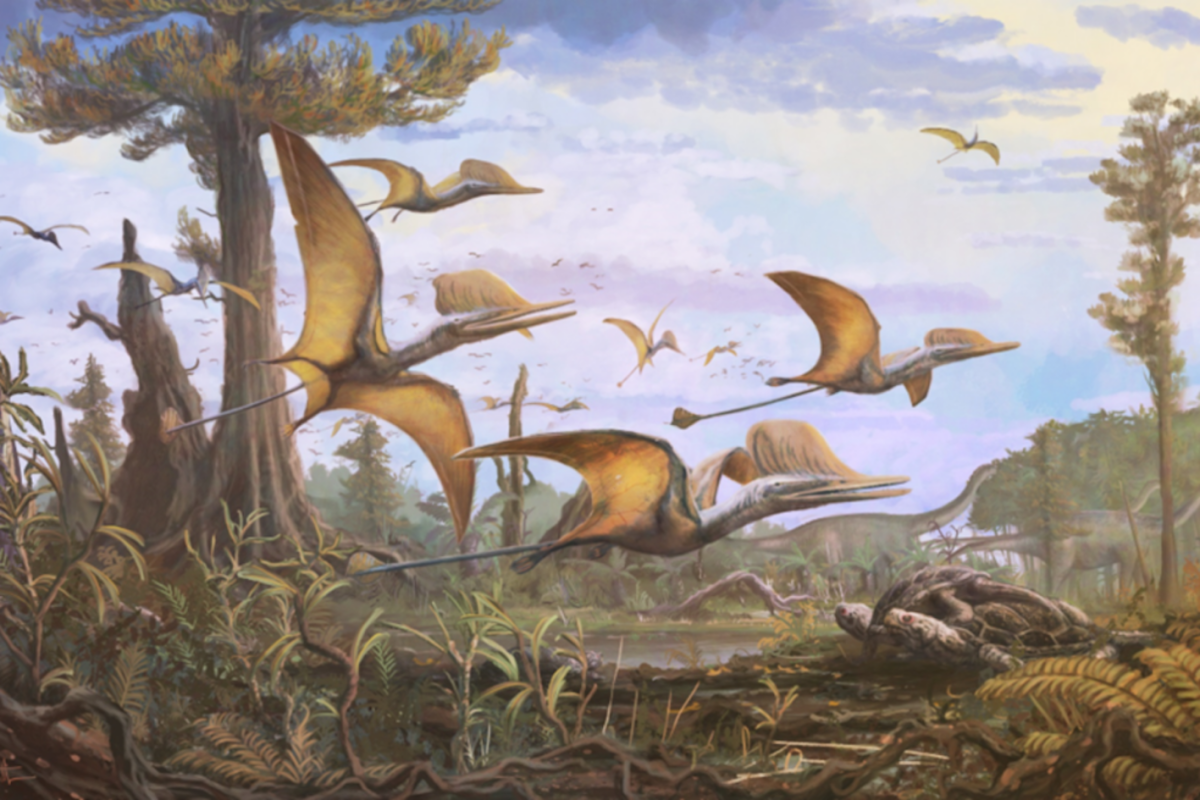A new species of pterosaur was discovered from a period and location that came as a "complete surprise" to the team of paleontologists.
The remains of the pterosaur were found on the Isle of Skye—an island located just off the northwest coast of mainland Scotland that is known for its rugged landscapes.
The new species, which has been named Ceoptera evansae, lived around 168-166 million years ago during the Middle Jurassic period (roughly 174-163 million years ago), according to a study published in the Journal of Vertebrate Paleontology that describes the prehistoric creature for the first time.
"We estimated the wingspan at 1.6 meters [5.2 feet] based on what we had and close relatives, so something similar to an osprey in size," Liz Martin-Silverstone, a palaeobiologist from the University of Bristol in the United Kingdom and lead author of the study, told Newsweek.
The latest discovery drastically improves the remarkably poor fossil record of Middle Jurassic pterosaurs, while providing important new insights into the diversity and evolutionary history of these ancient animals.

Pterosaurs are an extinct group of flying reptiles that appeared more than 200 million years ago and flourished throughout the age of the dinosaurs, with which they shared a common ancestor. Pterosaurs disappeared amid the mass extinction event around 66 million years ago that also famously wiped out their dinosaur relatives, in addition to many other forms of life on Earth.
The newly documented pterosaur was described based on the remains of a single individual—consisting of an incomplete skeleton that includes parts of the shoulders, wings, legs and backbone. Many of the bones remain completely embedded in rock and can only be studied using CT-scanning techniques.
The first word in the name of the new species is based on the Scottish Gaelic word "Cheò" meaning "mist" (a reference to the common Gaelic name for the Isle of Skye, which translates as "Isle of Mist") and the Latin suffix "-ptera," meaning "wing." The second word honors a researcher, Susan Evans, for her years of anatomical and palaeontological investigations, in particular, on the Isle of Skye.
The Middle Jurassic was a critical time in pterosaur evolution, but frustratingly for paleontologists, pterosaur fossils from this period are rare and consist almost exclusively of isolated fragmentary remains.
"During the Middle Jurassic pterosaurs were undergoing a transitional from the earlier long-tailed, small-bodied forms to the larger short-tailed forms that dominated the skies of the [subsequent] Cretaceous, but we have very few fossils from this time to understand how this transition took place. Ceoptera is one of those few animals that fills this gap," Martin-Silverstone told Newsweek.
"To find that there were more bones embedded within the rock, some of which were integral in identifying what kind of pterosaur Ceoptera is, made this an even better find than initially thought. It brings us one step closer to understanding where and when the more advanced pterosaurs evolved," Martin-Silverstone said in a press release.
The researchers were able to determine that Ceoptera represented a new species based on the presence of certain "unique" features, namely areas where muscles attached to the skeleton that are not found in other animals.
The paleontologists also conducted an analysis of the pterosaur's evolutionary relationships. This analysis provided additional support for the existence of a clade of pterosaurs called Darwinoptera, to which the researchers assigned several previously discovered species. Most species in this clade (a group of organisms that includes a single ancestor and all of its descendants) have been found in China.
"Ceoptera is the most complete darwinopteran pterosaur from the Middle Jurassic, a time that unfortunately reveals very few pterosaur fossils," Martin-Silverstone told Newsweek.
"Darwinoptera is controversial for a few reasons. Not everyone accepts it as a valid group, and some use a very similar group with a different name called Wukongopteridae."
The latest discovery suggests that Darwinoptera was considerably more diverse than previously thought, and that the group persisted for more than 25 million years from the late Early Jurassic (roughly 201-174 million years ago) to the latest parts of the Jurassic period, which ended around 145 million years ago. During these 25 million years, Darwinopteran species appeared to have spread around the world.

The latest study provides support for a new and more complex model for the early evolution of pterosaurs, indicating that all of the main pterosaur clades seen in the Jurassic evolved well before the end of the Early Jurassic—earlier than previously thought. The latest discovery also suggests that pterosaurs persisted into the latest parts of the Jurassic, alongside the group of dinosaurs which eventually evolved into modern birds.
"Ceoptera helps to narrow down the timing of several major events in the evolution of flying reptiles. Its appearance in the Middle Jurassic of the U.K. was a complete surprise, as most of its close relatives are from China," Paul Barrett, a researcher with the Natural History Museum in London and a senior author on the paper, said in a press release.
"It shows that the advanced group of flying reptiles to which it belongs appeared earlier than we thought and quickly gained an almost worldwide distribution."
Do you have an animal or nature story to share with Newsweek? Do you have a question about paleontology? Let us know via science@newsweek.com.
Uncommon Knowledge
Newsweek is committed to challenging conventional wisdom and finding connections in the search for common ground.
Newsweek is committed to challenging conventional wisdom and finding connections in the search for common ground.
About the writer
Aristos is a Newsweek science reporter with the London, U.K., bureau. He reports on science and health topics, including; animal, ... Read more
To read how Newsweek uses AI as a newsroom tool, Click here.








